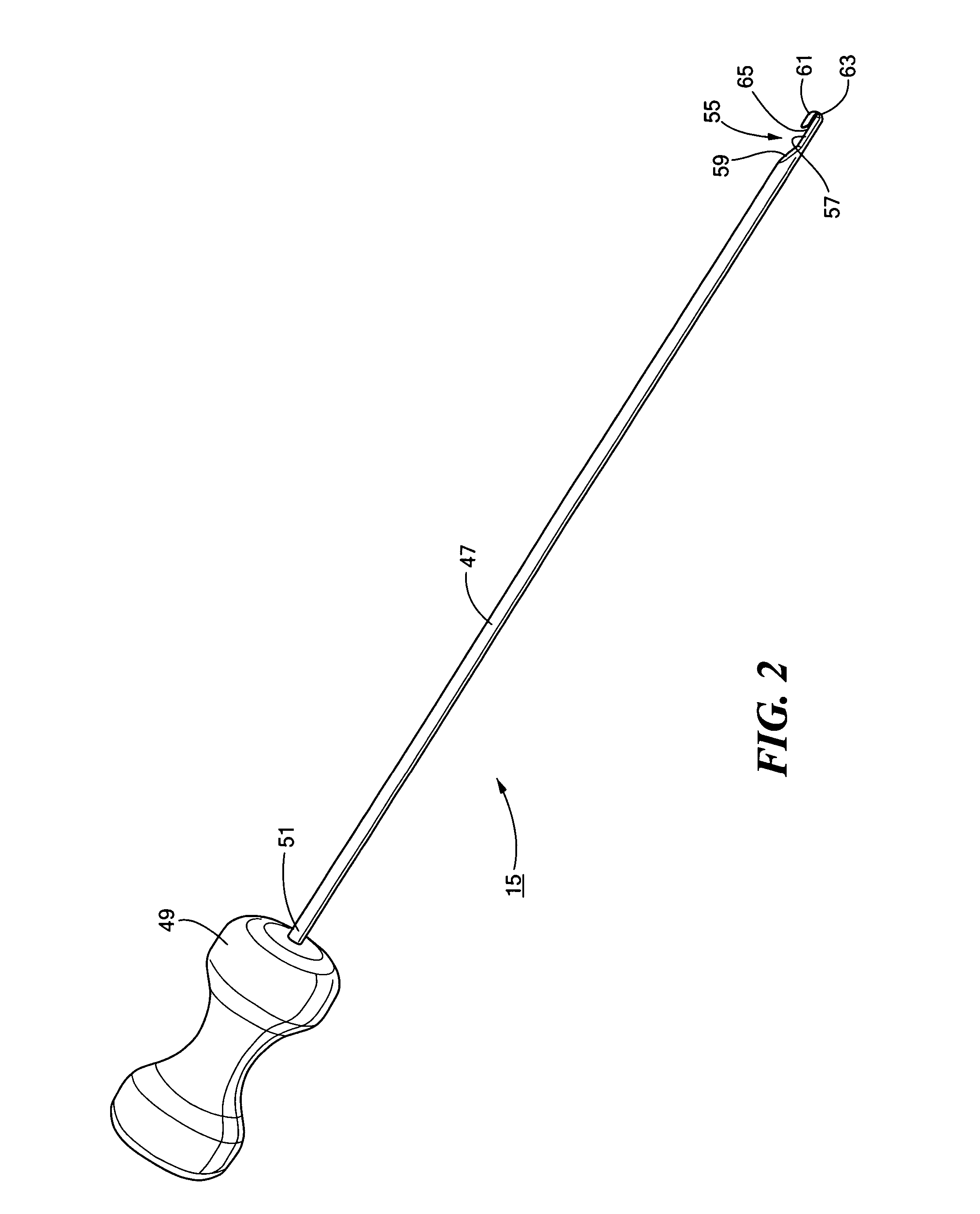Method for positioning a catheter guide element in a patient and kit for use in said method
a technology for guiding elements and medical catheters, applied in the field of medical catheters, can solve the problems of inability to take food and/or medications transorally, not well-suited for the long-term,
- Summary
- Abstract
- Description
- Claims
- Application Information
AI Technical Summary
Benefits of technology
Problems solved by technology
Method used
Image
Examples
first embodiment
[0026] Referring now to FIG. 1, there is shown an exploded perspective view of a kit constructed according to the teachings of the present invention, said kit being represented generally by reference numeral 11. As will be described below in further detail, kit 11 is adapted for use in positioning a guide element, such as a guidewire (i.e., pushwire) or a suture (i.e., pullwire), in a patient. A guide element, thus positioned, may be used to implant a medical catheter, such as a percutaneous endoscopic gastrostomy (PEG) tube, in the patient's body.
[0027] Kit 11 includes an access needle 13 and a guide element grasping tool 15.
[0028] Access needle 13 includes a cannula 17 and a stylet 19. Cannula 17, which is preferably a unitary structure made of molded plastic, includes a tubular member 21 and an annular flange 23. Tubular member 21, which has a longitudinal bore 22, is shaped to include a generally cylindrical distal portion 25, a generally cylindrical proximal portion 27, and a ...
second embodiment
[0039] It should be noted that numerous modifications could be rendered to kit 11 without departing from the spirit of the present invention. For example, in FIG. 6, there is shown a kit constructed according to the teachings of the present invention, said kit being represented generally by reference numeral 81.
[0040] Kit 81 is similar in certain respects to kit 1, the principal difference between the two kits being that kit 81 includes a guide element grasping tool 83, instead of guide element grasping tool 15. Guide element grasping tool 83 includes an elongated rigid shaft 85. A handle 87 is fixedly mounted on a proximal end 89 of shaft 85. A distal end 91 of shaft 85 is bifurcated to define a slot 93. Slot 93 is appropriately dimensioned to securely receive a portion of a guide element, such as a length of a pushwire or a loop of a pullwire.
[0041] It should be understood that guide element grasping tool 15 or guide element grasping tool 83 could be modified in other ways to pro...
third embodiment
[0042] Referring now to FIG. 7, there is shown a kit constructed according to the teachings of the present invention, said kit being represented generally by reference numeral 111.
[0043] Kit 111 is similar in certain respects to kit 11, the principal differences between the two kits being that kit 111 does not include separate stylet and J-hook components, but rather, includes a dual-function tool 113 whose distal end is shaped to include both a needle tip 115 and a J-hook 117. Consequently, tool 113 may be used in the same manner as both stylet 19 of kit 11 and tool 15 of kit 11.
PUM
| Property | Measurement | Unit |
|---|---|---|
| Structure | aaaaa | aaaaa |
Abstract
Description
Claims
Application Information
 Login to View More
Login to View More - R&D
- Intellectual Property
- Life Sciences
- Materials
- Tech Scout
- Unparalleled Data Quality
- Higher Quality Content
- 60% Fewer Hallucinations
Browse by: Latest US Patents, China's latest patents, Technical Efficacy Thesaurus, Application Domain, Technology Topic, Popular Technical Reports.
© 2025 PatSnap. All rights reserved.Legal|Privacy policy|Modern Slavery Act Transparency Statement|Sitemap|About US| Contact US: help@patsnap.com



